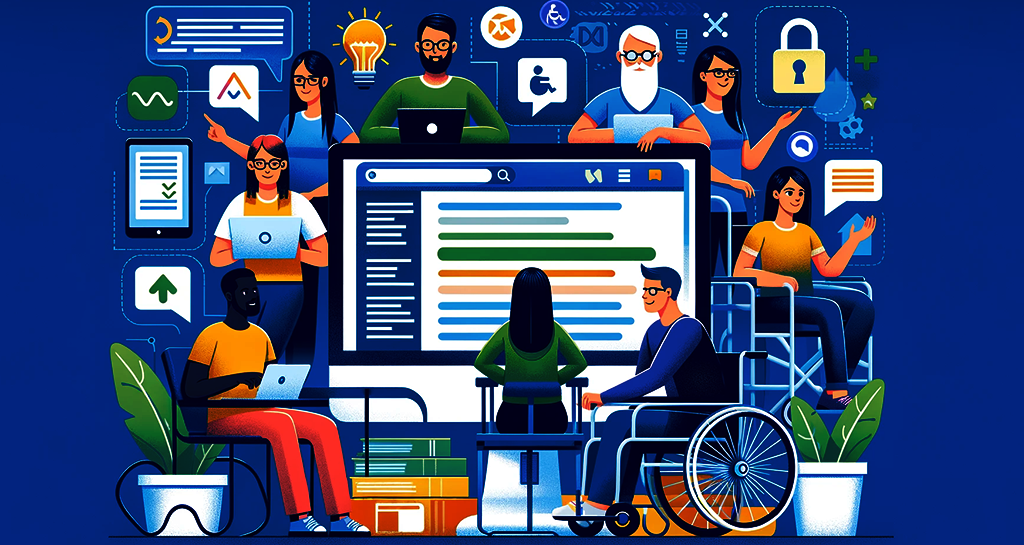- ⌘ It is a long established fact that a reader will distracted by the readable content of a page when looking an its readable ⌘
- It is a long established fact that a reader will distracted by the readable content of a page when looking an its readable ⌘
- It is a long established fact that a reader will distracted by the readable content of a page when looking an its readable ⌘
Designing for Accessibility: Best Practices
In an increasingly digital world, designing for accessibility is not just a legal requirement but a moral imperative. Accessibility ensures that all users, including those with disabilities, have equal access…
-
Read By - 4 minutes
-
Date - March 11, 2024
-
Category - Web/App Design Principles
-
Tags - Web/App Design Principles

In an increasingly digital world, designing for accessibility is not just a legal requirement but a moral imperative. Accessibility ensures that all users, including those with disabilities, have equal access to information and functionality. By incorporating accessibility best practices into your design process, you can create inclusive and user-friendly experiences for everyone. Here are some essential best practices for designing accessible digital products.
Understanding Accessibility
Accessibility in design means creating products that can be used by as many people as possible, including those with various disabilities. These disabilities can be:
– Visual: Blindness, low vision, color blindness.
– Hearing: Deafness, hard of hearing.
– Motor: Limited fine motor control, paralysis.
– Cognitive: Dyslexia, ADHD, learning disabilities.
By understanding the diverse needs of users, designers can create solutions that are inclusive and functional for everyone.
Best Practices for Accessibility
1. Use Semantic HTML:
– Why: Semantic HTML provides meaningful markup that assistive technologies can interpret.
– How: Use appropriate HTML elements for their intended purpose (e.g., `<nav>` for navigation, `<button>` for clickable buttons).
2. Provide Text Alternatives:
– Why: Users with visual impairments rely on screen readers to understand content.
– How: Include alt text for images, transcripts for audio, and captions for video content.
3. Ensure Keyboard Accessibility:
– Why: Some users cannot use a mouse and rely on keyboard navigation.
– How: Make sure all interactive elements (buttons, links, forms) can be accessed and operated via keyboard.
4. Use ARIA Landmarks and Roles:
– Why: ARIA (Accessible Rich Internet Applications) helps screen readers navigate complex interfaces.
– How: Implement ARIA roles and landmarks to define the structure and functionality of web elements.
5. Design for Color Blindness:
– Why: Color blindness affects how users perceive color-based information.
– How: Use high-contrast color schemes, avoid relying solely on color to convey information, and test your design with color blindness simulators.
6. Create Accessible Forms:
– Why: Forms are a crucial part of user interaction, especially for tasks like registration and checkout.
– How: Ensure form labels are associated with their corresponding input fields, provide clear instructions, and include error messages that describe how to correct issues.
7. Implement Responsive Design:
– Why: Users access content on a variety of devices with different screen sizes and orientations.
– How: Use responsive design techniques to ensure your layout adapts to various screen sizes, and consider touch targets for mobile users.
8. Provide Clear and Consistent Navigation:
– Why: Consistent navigation helps users understand and predict how to move through your site.
– How: Maintain a consistent layout, use clear headings and labels, and ensure breadcrumb navigation is available.
9. Use Legible Fonts and Sufficient Text Size:
– Why: Readable text is essential for users with visual impairments or cognitive disabilities.
– How: Choose readable fonts, ensure sufficient contrast between text and background, and use relative units (like em or rem) for font sizes to support text scaling.
10. Conduct Regular Accessibility Testing:
– Why: Continuous testing helps identify and fix accessibility issues.
– How: Use automated tools, conduct manual testing, and involve users with disabilities in usability testing.
Benefits of Designing for Accessibility
Designing for accessibility has numerous benefits beyond compliance with legal standards:
– Wider Audience Reach: Making your product accessible means reaching a larger audience, including the 15% of the global population that experiences some form of disability.
– Improved Usability: Accessibility improvements often enhance the overall user experience for everyone, not just those with disabilities.
– Enhanced SEO: Search engines reward accessible websites with better rankings, as accessibility features often align with SEO best practices.
– Positive Brand Image: Demonstrating a commitment to accessibility can boost your brand’s reputation and foster customer loyalty.
Conclusion
Designing for accessibility is about creating inclusive digital experiences that respect and accommodate all users. By implementing these best practices, designers can ensure their products are usable, functional, and enjoyable for everyone. Accessibility is not just a feature; it’s a fundamental aspect of good design that benefits both users and businesses. As the digital landscape continues to evolve, making accessibility a core part of your design process is essential for creating a more inclusive and equitable online world.
